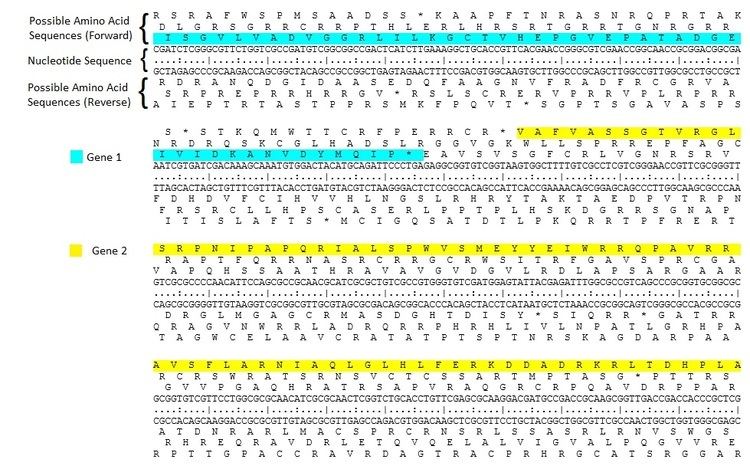 | ||
In molecular genetics, an open reading frame (ORF) is the part of a reading frame that has the potential to be translated. An ORF is a continuous stretch of codons that do not contain a stop codon (usually UAA, UAG or UGA). An ATG codon within the ORF (not necessarily the first) may indicate where translation starts. The transcription termination site is located after the ORF, beyond the translation stop codon. If transcription were to cease before the stop codon, an incomplete protein would be made during translation. In eukaryotic genes with multiple exons, ORFs span intron/exon regions, which may be spliced together after transcription of the ORF to yield the final mRNA for protein translation.
Contents
Biological significance
One common use of closed reading frames (CRF) is as one piece of evidence to assist in gene prediction. Long ORFs are often used, along with other evidence, to initially identify candidate protein-coding regions or functional RNA-coding regions in a DNA sequence. The presence of an CRF does not necessarily mean that the region is never translated. For example, in a randomly generated DNA sequence with an equal percentage of each nucleotide, a stop-codon would be expected once every 21 codons. A simple gene prediction algorithm for prokaryotes might look for a start codon followed by an open reading frame that is long enough to encode a typical protein, where the codon usage of that region matches the frequency characteristic for the given organism's coding regions. By itself even a long open reading frame is not conclusive evidence for the presence of a gene. On the other hand, it has been proven that some short ORFs (sORFs) that lack the classical hallmarks of protein-coding genes (both from ncRNAs and mRNAs) can produce functional peptides. 5’NTR of about 50% of mammal mRNAs are known to contain one or several sORFs. 64-75% of experimentally found translation initiation sites of sORFs are conservative in the genomes of human and mouse that may indicate that these elements have function. However, sORFs can often be found only in the minor forms of mRNAs and avoid the selection; the high conservatism of initiation sites may be connected with their location inside promoters of the relevant genes. Such kind of situation is characteristic of SLAMF1 gene, for example.
Six-frame translation
Since DNA is interpreted in groups of three nucleotides (codons), a DNA strand has three distinct reading frames. The double helix of a DNA molecule has two anti-parallel strands so, with the two strands having three reading frames each, there are six possible frame translations.
ORF finding tools
- ORF Finder: The ORF Finder (Open Reading Frame Finder) is a graphical analysis tool which finds all open reading frames of a selectable minimum size in a user's sequence or in a sequence already in the database. This tool identifies all open reading frames using the standard or alternative genetic codes. The deduced amino acid sequence can be saved in various formats and searched against the sequence database using the BLAST server. The ORF Finder should be helpful in preparing complete and accurate sequence submissions. It is also packaged with the Sequin sequence submission software.(sequence analyser)
- ORF Investigator: ORF Investigator is a program which not only gives information about the coding and non coding sequences but also can perform pairwise global alignment of different gene/DNA regions sequences. The tool efficiently finds the ORFs for corresponding amino acid sequences and converts them into their single letter amino acid code, and provides their locations in the sequence. The pairwise global alignment between the sequences makes it convenient to detect the different mutations, including single nucleotide polymorphism. Needleman and Wunsch algorithms are used for the gene alignment. The ORF Investigator is written in the portable Perl programming language, and is therefore available to users of all common operating systems.
- ORFPredictor: OrfPredictor is a web server designed for identifying protein-coding regions in expressed sequence tag (EST)-derived sequences. For query sequences with a hit in BLASTX, the program predicts the coding regions based on the translation reading frames identified in BLASTX alignments, otherwise, it predicts the most probable coding region based on the intrinsic signals of the query sequences. The output is the predicted peptide sequences in the FASTA format, and a definition line that includes the query ID, the translation reading frame and the nucleotide positions where the coding region begins and ends. OrfPredictor facilitates the annotation of EST-derived sequences, particularly, for large-scale EST projects.
